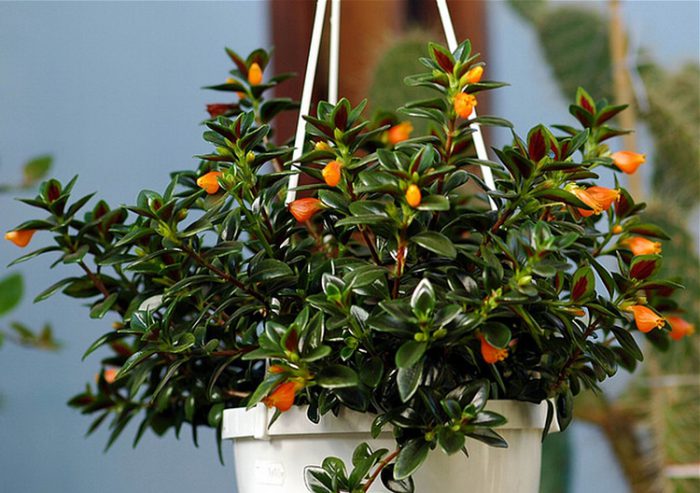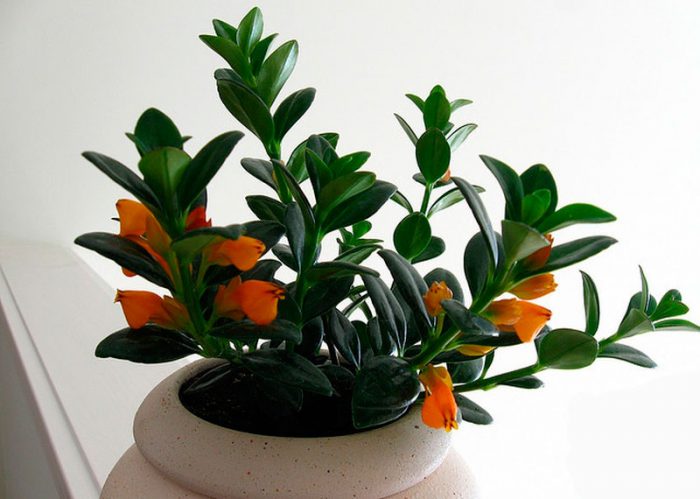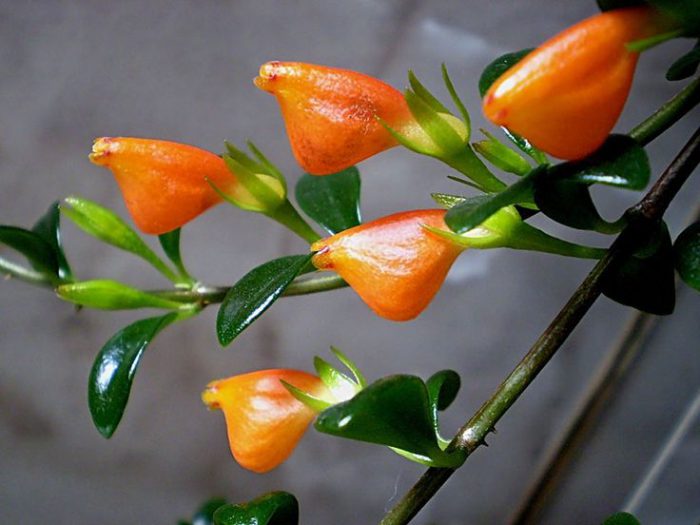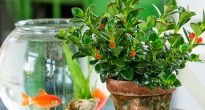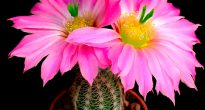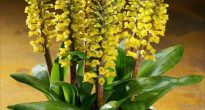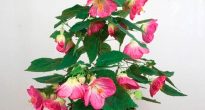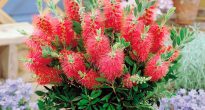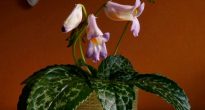A plant like hypocyrt is directly related to the Gesneriaceae family. Its distinctive feature is the flowers, which are similar to lips folded for a kiss, while the petals can be colored orange or yellow. The hypocyrt is grown both as an ampelous plant and simply in a flowerpot on the windowsill. Every year such a plant is becoming more and more popular with flower growers.
The genus Hypocyrta (Hypocyrta) unites more than 30 species of rather delicate dwarf shrubs. Leaflets from obovate to elliptical in shape have a pointed end. Their surface can be either pubescent or smooth. The seamy side is often light purple in color. In summer, tubular flowers appear in the leaf sinuses, the lower part of which is swollen. Semi-erect species reach a height of 40-60 centimeters, and creeping - 10-15 centimeters. Florists appreciate this plant for its spectacular foliage and flowers.
At the moment, according to the international code of botanical nomenclature, the genus of hypocyrt no longer exists. Most of the species belonging to him are now included in the genus Nematanthus. This name comes from the Greek words νημα "mute" - thread, hair and άνθος "anthos" - flower. This is because in most species of this genus, flowers hang on thin peduncles.
Some of the species of the genus hypocyrt now belong to the following genera of the Gesnerian family: neomortonia, besleria, drymonium, codonant, columnea, coritoplelectus, and paradrimonium.
Content
Hypocyrtal care at home
Temperature regime
In the summer, a moderate temperature is required (20-25 degrees). In winter, a naked hypocyrte requires a temperature of 12 to 14 degrees, a coin hypocyrte - from 14 to 16 degrees. Moreover, in winter, the room should not be colder than 12 degrees.
Illumination
The plant needs bright lighting, but the light must be diffused. Shading is required from direct sunlight. In winter, the illumination should also be good.
How to water
In the summer, watering should be abundant. With the onset of autumn, it should be reduced. With a cool wintering, watering is needed meager, but at the same time the earthen lump should not dry out completely.
Top dressing
The plant is fed once a week from April to August. To do this, use a solution of mineral fertilizers for flowering indoor plants.
Humidity
In summer, the flower needs high humidity. It is recommended to increase it by frequent moistening of the foliage from a sprayer.
Transplant features
The transplant is carried out once a year in the spring. To do this, take a not too large pot. Suitable soil should be loose and light. The soil mixture consists of peat and leaf soil, as well as river sand, taken in a ratio of 1: 3: 0.5. It is recommended to add fern roots or chopped bark to the soil mixture, as well as charcoal. For planting, you can purchase ready-made soil for Saintpaulias.
Growing features
Hypocyrta is not very demanding for care. In the summertime, it can be moved to fresh air by choosing a shaded place for it. In winter, the flower must be transferred to a well-lit and cool place (about 12 degrees). During this period, it is necessary to water the plant sparingly and carefully. The abundance of summer flowering depends on how the correct dormancy period was provided to the plant. Frequent pruning of the stems will help stimulate profuse flowering, while the plant will bush more.
With a lack of light, the stems stretch and become thinner, and flowering becomes more scarce. Stagnant water in the soil can lead to the development of root rot, as well as the fall of foliage. Because of this, underfilling is much better than overflowing. On hot summer days, in any case, water the plant abundantly. In the period from May to September, when there is intense growth, you need to feed the flower with full fertilizer for indoor flowers once every 1.5 weeks. In the spring, hypocyrtes need to be transplanted into a light, nutrient-rich substrate that allows water to pass through.
Features of transplantation and reproduction
To transplant such a plant, you should opt for a loose and fairly light substrate. A suitable soil mixture consists of leaf and humus soil, as well as sand and peat, taken in equal parts. You can use the ready-made Saintpaulia soil mixture, which is sold in the store. When transplanting at the bottom of the container, do not forget to make a good drainage layer that will prevent the liquid from stagnating in the soil. A small pot should be chosen, because the roots of such a plant are quite small. Since this is a slow-growing plant, it is recommended to transplant it once every 2 or 3 years and always in the spring.
The plant can be easily and quickly propagated by cuttings. Thus they propagate in the spring and summer. Not very large stems are cut into cuttings, which must have 4 or 5 nodes. They quickly take root in a glass of water or in a mixture of sand and peat. A couple of lower leaves should be cut off, and the cutting itself should be buried in the substrate to the first leaf. After that, the container must be covered with foil or glass until the cutting takes root well.
When growing an ampel plant in a pot, you should plant several bushes (3-4 pieces). And for a bush form, 1 seedling should be planted in a pot and its tops should be regularly pinched.
Diseases and pests
Drafts and a sharp change in temperature have a negative effect on this plant. If in winter it is warm, then it often settles on it aphid... In the event that you cannot find a cool place for the wintering of the plant, you can transfer it to the "boarding house" for a while. The chosen place must be bright and free of drafts. Watering should be extremely moderate.
Most often, diseases are associated with violations of the rules of care:
- The plant sheds buds and foliage - overflow or too low air temperature.
- Foliage becomes faded and turns yellow - too low air humidity, an excess of fertilizers in the soil or the plant has been exposed to direct sunlight for a long time.
- Foliage curls and turns yellow - overly intense lighting. Shade the plant from direct sunlight.
- The appearance of brownish specks on the surface of the leaves - too cold water is used for irrigation. Thus, the plant can react to irregular watering, for example, the substrate is either too wet, or vice versa, too dry.
- There is a grayish bloom on the leaves and flowers - the plant is infected with powdery mildew (gray mold). May appear as a result of improper care. Stop wetting the plant with a sprayer and remove the affected leaves and flowers. Treat with a special fungicide.
- Lean flowering or the plant does not bloom at all - there is a lack of light, there are few nutrients in the ground, or clay soil was used for planting, low air humidity, or the room is rather cold. The reason may also be a warm wintering in a darkened place, as well as the lack of pruning of old stems in the spring.
Main types
2 types of the genus hypocyrt are especially loved by flower growers, but now they belong to the genus Neomortonia and nematanthus (family Gisneriaceae).
Hypocyrta nummularia
This plant is ampelous and has weakly branching stems. Pale green, fleshy leaves are round in shape. They are crenate along the edge and reach about 2 centimeters in length. On the surface of foliage and shoots, there are not very many small hairs. The flowers are deep red with a yellow corolla limb. As a rule, after the end of flowering, foliage falls off. At the moment this plant is called Neomortonia nummularia and it belongs to the genus Neomortonia.
Hypocyrta glabra
Such a plant is semi-ampelous and has weakly branching stems. Glossy, fleshy, bright green leaves have an elliptical shape. They have no pubescence, and reach 2 to 4 centimeters in length. In the leaf axils, from 1 to 3 pieces of flowers are formed. The corolla consists of fused waxy petals of a deep orange color, and forms a swelling below. At the end of flowering, foliage is not observed to fall. At the moment, such a plant is called nematanthus strigillosus and it belongs to the genus nematanthus.


